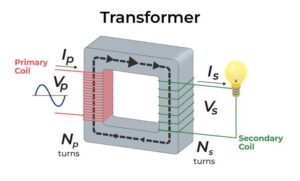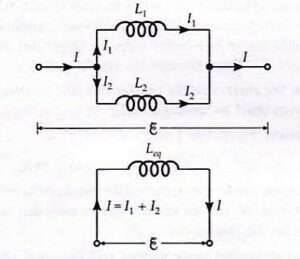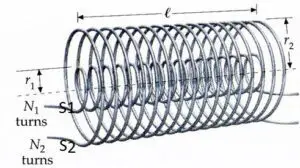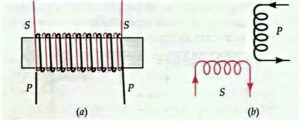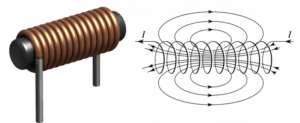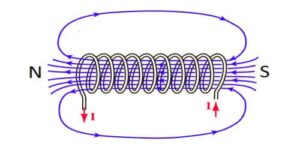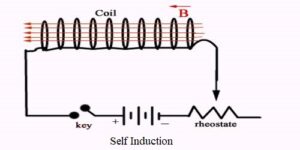In this article, we will talk about the experiments performed by the faraday and henry. It is very important for us to know the experiments performed by faraday and henry for a better understanding of the concept of electromagnetic induction. So let’s get started…
Faraday’s experiments
Faraday’s experiments: The phenomenon of electromagnetic induction was discovered by Michael Faraday in 1831. And it can be understood by the following experiments performed by the faraday and henry.
Experiment-1: Induced EMF with a stationary coil and moving magnet
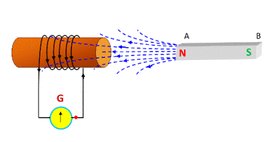
As shown in the above figure, take a strong bar magnet and an insulated copper coil. Join both open ends of the wire to the sensitive galvanometer.
- When the N-pole of the strong bar magnet moves towards the coil, the galvanometer shows a deflection, say right of the zero mark.
- When the N-pole of the bar magnet moves away from the coil, the galvanometer shows deflection in the opposite direction, say the left side of the zero mark.
- If the above process is carried out by bringing the S-pole of the bar magnet towards or away from the coil, then the direction of the current induced is in the opposite direction as that obtained in the case of the N-pole.
- If the magnet is held stationary anywhere on the coil whether inside or outside, the galvanometer shows null deflection showing zero induced current.
Read Also
Explanation of experiment-1
When a bar magnet is placed near a coil, a number of magnetic lines of force pass through it. As the magnet is moved closer to the coil, the magnetic flux (the total number of magnetic lines of force) linked with the coil increases. It induced an EMF in the coil hence an induced current is set up in the coil in one direction.
As the magnet is moved away from the coil, the magnetic flux linked with the coil decreases. It induced an EMF in the coil and hence an induced current is set up in the coil in the opposite direction. As soon as the relative motion between magnet and coil ceases, the magnetic flux linked with the coil stops changing, and so the induced current in the coil becomes zero.
Experiment-2: Induced EMF with a stationary magnet and moving coil

If we make the magnet static and move the coil, then we will see similar results as in experiment 1. See the (b) part of the above image. When the relative motion between the coil and the magnet is fast, the deflection in the galvanometer is larger, but the relative motion is slow, then the deflection will be small.
Faster the relative motion between the coil and the magnet, greater is the rate of change of magnetic flux linked with the coil and resultant larger the induced current setup in the coil.
Experiment-3: Induced EMF by the varying current in the nearby coil

In the above figure, there are two coils named coil-1 and coil-2, Here coil-1 is called the primary coil, connected to the battery through a tapping key K, and coil-2 is called the secondary coil, connected to the galvanometer a little apart from the primary coil.
- When the tapping key is pressed, the galvanometer shows a momentary deflection in one direction. But when the key is released, it again shows a momentary deflection but in the opposite direction.
- If the tapping key is kept pressed so as the steady current flows through the primary coil, the galvanometer does not show any deflections.
- As the current in the primary coil is increased with the help of a rheostat, the induced current flows in the secondary coil in the same direction as that at the make of the primary coil.
- As the current in the primary coil is decreased, the induced current flows in the secondary coil in the same direction as that at the break of the primary coil.
- The deflections of the galvanometer can be larger if the cylindrical support of the coils is of iron.
Read Also
- Magnetic flux – definition, formula, units, and dimensions
- Moving coil galvanometer class-12, definition, working principle, construction, and Applications
Explanation of experiment-3
When a current flows through a coil, a magnetic field gets associated with it. As the primary circuit is closed, the current through it increases from zero to a certain steady value. The magnetic flux linked with the primary and hence with the secondary also increases. This sets up an induced current in the secondary coil in one direction. As the primary circuit is broken, the current decreases from the steady value to zero, and the magnetic flux through the secondary coil decreases. An induced current is set up in the secondary coil but in the opposite direction. When a steady current flows in the primary coil, the magnetic flux linked with the primary coil does not change and no current is induced in the secondary coil. From these experiments, we may conclude that:
1. Whenever the magnetic flux linked with a closed circuit changes, an emf is induced and hence an induced current is set up in it.
2. The higher the rate of change of magnetic flux linked with the closed circuit, the greater the induced emf or current.
Stay tuned with Laws Of Nature for more useful and interesting content.

